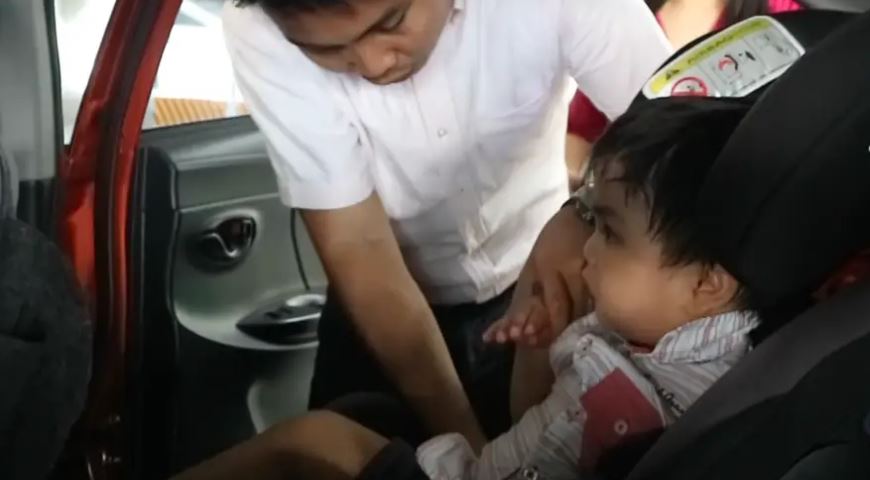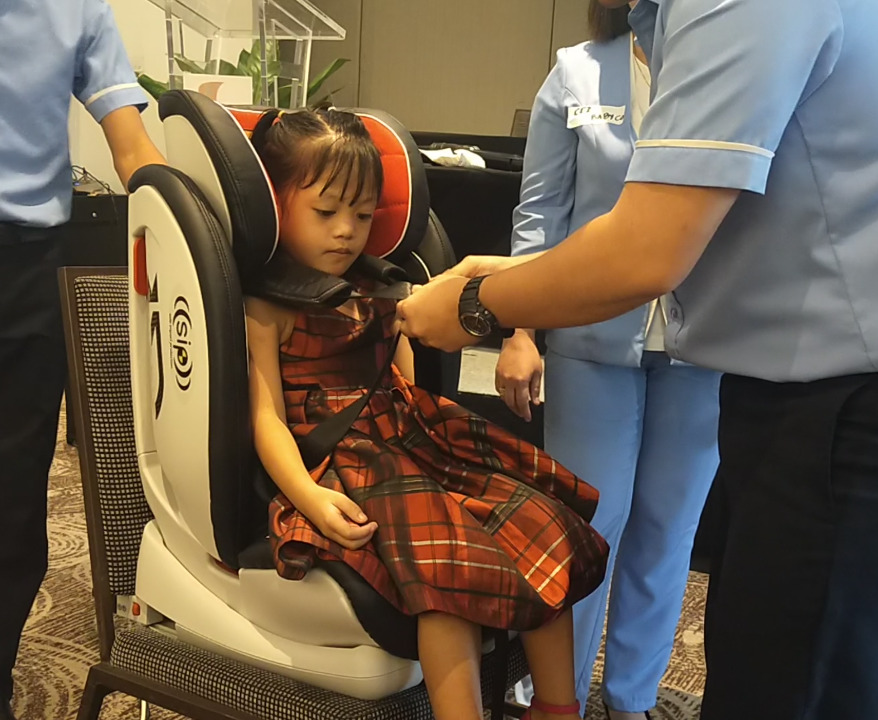In May last year, three girls suffocated after being locked in a parked car.
The cousins, aged six, eight and nine years, got into the vehicle to play but could not get out because the lock was broken from inside. By the time an adult came looking for them, the children were motionless and were declared dead on arrival at a hospital in Bataan province, according to police.
Something similar happened to an eight-year-old girl in January 2017. After a few tiring hours in a mall in Pasay city, she fell asleep on the back of a borrowed car without family members knowing it. They found her lifeless body when they checked the vehicle hours later.
In September 2018, six primary school children were shown in a video standing side by side in the trunk of an SUV, stuffed like sardines in Manila. Minutes later, the door was shut and the vehicle prepared to leave as a group of adults stood by.
In another incident over five years ago, a three-year-old boy was injured when the car taking him to a pre-school was involved in a collision with another vehicle in Quezon City. The toddler, seated in front without any protective device, may have hit the dashboard because his three front teeth were forced into his gums and had to be surgically removed, according to a news report.
These are the types of incidents which the Child Safety in Motor Vehicle Act (RA 11229), which takes effect in February next year, aims to prevent.
“Child safety is our priority,” the Department of Transportation (DOTr) said in a statement, adding that the law aims to ensure the safety and welfare of child passengers and prevent traffic-related injuries and deaths.
The law mandates the use of car restraint systems (CRS) by infants and children 12 years and below while being transported in private motor vehicles. These car seats – rear-facing or forward-facing seats and booster seats – must comply with international safety and quality standards.

RA 11229 also prohibits kids from sitting in front of a vehicle, unless the child is four feet and eleven inches (4’11) in height, but he or she should be properly secured using a regular seat belt.
The law also states that at no instance shall a child be left unaccompanied by an adult inside a motor vehicle.
Mandatory compliance by Feb 2021

The law was signed by President Rodrigo Duterte in February last year and its implementing rules and regulations were approved and signed last December.
But mandatory compliance with RA 11229 will start only in February next year to provide sufficient time for concerned government agencies to prepare for its implementation, the DOTr said.
The next 12 months will be used to mount a nationwide information and education campaign on the use of child restraints.
This entails the dissemination of information on the appropriate car seats based on the age and height of the child, the CRS’ proper installation, its safety features, consumer guidelines in purchasing child car seats, and other provisions of the law the public ought to know about, such as exceptions to the rule.
The use of CRS will not be required if it puts a child in danger during an emergency or when the child being transported has a medical, mental, psychological or developmental condition or disability and securing him or her in a child car seat could harm the kid’s health and safety.
During the one-year transitory period, the Land Transportation Office (LTO) will also be implementing a nationwide training program to build the capacity of its men in enforcing the law’s provisions and procedures.
An important guideline in implementing RA 11229 is that an enforcer should determine any violation only through visual inspection so as not to cause distress to any child passenger.
Children are not small adults
Lawyer Melissa Comfay from the non-profit IDEALS (Initiatives for Development and Empowerment through Alternative Legal Services) says the law highlights the child’s rights to proper care, health and safety.
“It can change mindsets of looking at how a child is very different from an adult from the perspective of health and to inform everyone that road safety is a health issue.”
“As in any health issue, prevention is always better than cure,” she pointed out as she advised parents to take precautions and minimize risk.
Two car seats (rear-facing and front-facing) undergo a crash test by the New Car Assessment Program for Southeast Asian Countries (ASEAN NCAP).
The World Health Organization (WHO) says child restraints are “highly effective in reducing injury and death to child occupants” as they keep kids from being thrown against the car interior, from hitting other car occupants, or from being ejected from the vehicle.
These restraints come in the form of car seats, booster seats or car beds designed to diminish the risk of injury to a child because they limit a child’s mobility in the event of a collision or abrupt stop.
If correctly installed and used, these devices reduce deaths among infants by about 70 percent and up to 80 percent among small children, the WHO says.
A car seat needs to “limit forward head movement in a frontal impact and provide protection from intrusion in a side impact. A child restraint should therefore distribute the crash forces over as wide as area as possible,” according to a WHO road safety manual.
Children are vulnerable
In its 2018 Global Status Report on Road Safety, the WHO said road traffic injuries are the leading cause of death among children and young adults aged 5–29 years.
In the Philippines, road traffic injuries continue to claim the lives of an average of 600 children below the age of 15, according to data from the 2016 Report of the Philippine Statistics Authority (PSA).
Road safety advocates have pushed for the mandatory use of CRS and stop the common practice of an adult carrying a child on one’s lap and protecting the kid with one’s arms.

The Seat Belts Act of 2009 and RA 11229 emphasize the importance of buckling up using the appropriate belt type depending on the age, weight, and height of the child.
While a child can be as tall or as heavy as an adult, the difference can boil down to bone structure.
The front seat passenger may be protected with an airbag in case of a collision, but a child’s bone structure is “too delicate to take the full impact of an airbag,” said Comafay.
A 2013 WHO study states that seating infants and children in a place with an airbag is harmful. “The bone-forming process is not complete until the age of 6 or 7 years, and throughout childhood, a child’s skill remains less strong than that of an adult,” according to a WHO road safety manual.
“A child needs care and attention of an adult who can see to it that the child is kept from harm’s way,” Comafay pointed out, adding that leaving a child in the car even for a short period and even if the kid is properly secured in a car seat, is a violation of the law.
“In this new law, the drivers are seen as the responsible ones for allowing or disallowing the act and would be penalized for leaving the child unattended. There is no exception,” said the road safety advocate, who is also part of the Buckle Up Kids PH campaign.
“If we could minimize the injury or death of the child while traveling on the road, then give that child the much needed protection too by not allowing him or her to sit in front and not leaving him or her unattended at anytime while in the motor vehicle,” she added.
PUVs excluded
RA 11229 does not cover public utility vehicles such as taxis, vans, school buses and regular passenger buses but the DOTr is tasked to conduct a feasibility study to determine if it should require public transport to adopt CRS use.
If the DOTr determines that the mandatory use of child car seats is not feasible in public utility vehicles, it will recommend to Congress the necessary legislative measures for the safe and secure transportation of children in such vehicles.
“Nothing in RA 11229 … shall preclude the DOTr from adopting measures within its mandate to protect and promote the safety of children,” says a provision in the law’s implementing rules and regulations.




